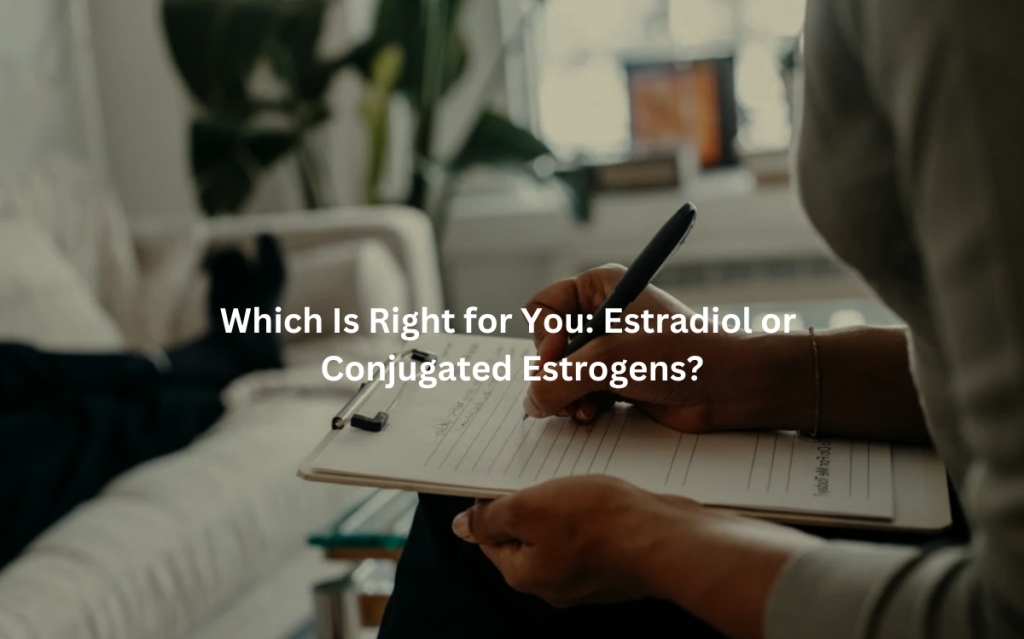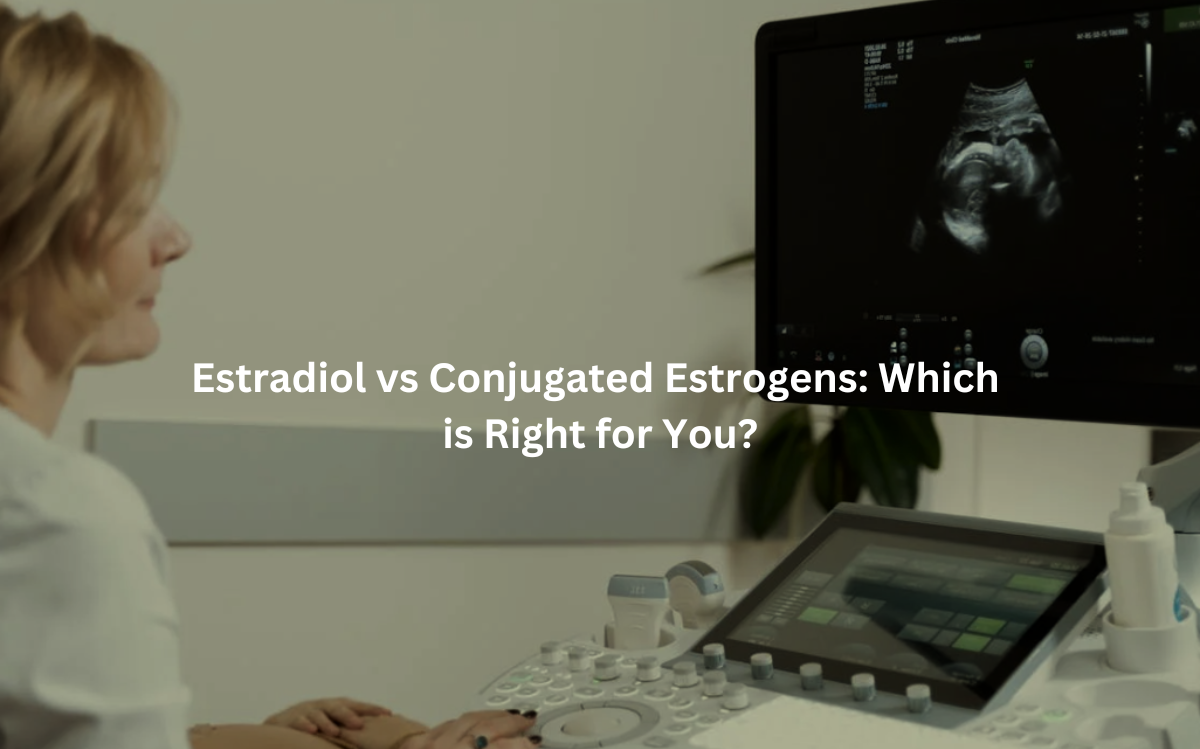Learn how estradiol and conjugated estrogens compare, and which one is best suited for your health needs.
Estrogen replacement therapy (ERT) is a popular solution for managing menopausal symptoms, but with options like estradiol and conjugated estrogens, it can be difficult to choose. (1)
Each type of estrogen has its own benefits, risks, and best-use cases. This article breaks down the differences between these two treatments, helping you understand which one may be most effective for your health needs.
Key Takeaway
- Estradiol is often prescribed for its effectiveness in relieving menopausal symptoms.
- Conjugated estrogens are typically used for women who need a broader spectrum of estrogen support.
- Both treatments have benefits and risks that must be assessed individually.
Estradiol: A Powerful Estrogen for Symptom Relief
Estradiol is one of the most commonly prescribed forms of estrogen therapy. It’s the most bioidentical form of estrogen available, meaning it is structurally identical to the estrogen naturally produced by the body.
For women dealing with severe menopausal symptoms, estradiol can offer significant relief, particularly for hot flashes, night sweats, and vaginal dryness. (2)
Estradiol is often delivered via a transdermal patch, oral tablets, or gel. The patch is particularly beneficial for women who have a history of blood clots, as it avoids the liver’s first-pass metabolism, which can be a concern with oral forms.
On the downside, oral estradiol might be preferred for its ease of use but comes with the increased risk of blood clots, especially in those with other risk factors like obesity or smoking.
Benefits of Estradiol
- Effective for Hot Flashes and Night Sweats: Estradiol works quickly to reduce vasomotor symptoms, which include those dreaded hot flashes. Many women report relief within days of starting treatment.
- Supports Vaginal Health: It can help maintain vaginal moisture, which is a common complaint during menopause. Dryness often leads to discomfort during sex and urinary tract infections, both of which can be alleviated with estradiol.
- Bone Health Protection: As estrogen levels drop, bone density also decreases, putting women at risk for osteoporosis. Estradiol helps to mitigate this effect, offering protection against bone loss.
Risks of Estradiol
- Blood Clot Risk: Oral estradiol is associated with an increased risk of blood clots, which can lead to deep vein thrombosis (DVT) or pulmonary embolism.
- Breast Cancer Risk: Long-term use of estradiol can increase the risk of breast cancer, particularly when used in combination with progestin (for women with an intact uterus).
- Potential Side Effects: Some women experience headaches, nausea, or bloating when starting estradiol. These side effects tend to subside after a few weeks of treatment, but it’s important to monitor them closely.
Conjugated Estrogens: A Broader Spectrum of Estrogen Therapy
Conjugated estrogens are a mixture of estrogen compounds that are typically derived from the urine of pregnant mares (though synthetically produced versions are also available).
These estrogens include estrone sulfate, equilin sulfate, and other estrogens that are less commonly found in estradiol treatments. Conjugated estrogens can be effective in treating menopausal symptoms and offer a broader range of estrogen effects.
Unlike estradiol, which is primarily used for symptom relief, conjugated estrogens are more versatile. They are often used for women who require estrogen support across multiple aspects of health—beyond just managing hot flashes or night sweats. These include protecting heart and bone health, as well as improving mood and cognitive function, which can be affected during menopause.
Benefits of Conjugated Estrogens
- Versatility in Treatment: Conjugated estrogens can be used for a wider range of symptoms, from vasomotor symptoms to mood disturbances, insomnia, and even cognitive decline.
- Convenient Dosage Forms: Conjugated estrogens are available in several forms, including oral tablets and injectable options, giving women flexibility in how they administer their treatment.
- Effective Long-Term Protection: Conjugated estrogens help reduce the risks associated with osteoporosis and cardiovascular diseases, which tend to rise after menopause.
Risks of Conjugated Estrogens
- Breast Cancer Risk: Similar to estradiol, long-term use of conjugated estrogens has been linked to a small increased risk of breast cancer. The risk appears to be higher when the therapy is combined with progestins.
- Blood Clot Risk: Conjugated estrogens, like estradiol, carry an increased risk of blood clots, which can lead to potentially serious complications. Women who have risk factors such as obesity or smoking need to be monitored carefully.
- Heart Disease Concerns: In some studies, conjugated estrogens have been linked to an increased risk of heart disease, particularly in older women or those starting therapy long after menopause.
Which Is Right for You: Estradiol or Conjugated Estrogens?

Choosing between estradiol and conjugated estrogens depends on your specific needs, medical history, and the symptoms you’re trying to address.
If your primary concern is managing hot flashes and night sweats, estradiol may be the better option due to its potency and focus on those particular symptoms. However, if you’re looking for a broader range of benefits—such as improved mood, cognitive support, and long-term bone health—conjugated estrogens might be the way to go.
It’s also important to factor in your personal health history. For women with a history of blood clots, a transdermal estradiol patch might be the safest option. On the other hand, conjugated estrogens might be beneficial for women who have already experienced menopause and are looking for long-term health benefits.
Important Considerations
- Health History: If you’ve had a history of blood clots or heart disease, transdermal estradiol may be a better option over oral forms of either estradiol or conjugated estrogens.
- Duration of Use: Both estradiol and conjugated estrogens should be used at the lowest effective dose for the shortest duration necessary to manage symptoms. Long-term use should always be carefully monitored.
- Side Effects: If you experience significant side effects with one form of estrogen, it’s worth trying the other to see if it provides better relief with fewer complications.
Conclusion: Choose Wisely, Monitor Closely
The choice between estradiol and conjugated estrogens isn’t always straightforward. Both have their benefits and risks, making it essential to carefully consider the symptoms you want to relieve and any underlying health conditions.
Regardless of which estrogen therapy you choose, regular monitoring by your doctor is crucial. Frequent check-ins will help adjust dosages, assess side effects, and ensure that your treatment remains effective and safe.
Estrogen therapy can provide significant relief, but it requires ongoing commitment and careful adjustments. The right approach can help manage menopause symptoms and safeguard long-term health.
If you’re ready to explore your options, book a consultation with Modern Menopause today and get expert guidance for your needs. Book now.
FAQ
What is the difference between estradiol and conjugated estrogens in hormone therapy for menopause?
Estradiol and conjugated estrogens are both used in hormone therapy to manage menopause symptoms. Estradiol is a synthetic form of estrogen, while conjugated estrogens come from the urine of pregnant mares.
Both are effective for treating menopause symptoms like hot flashes, vaginal dryness, and atrophic vaginitis. However, conjugated estrogens are often used for systemic therapy, while estradiol can be administered in various forms like oral tablets or vaginal creams.
Are there any risks associated with estradiol and conjugated estrogens for women with heart disease?
For women with heart disease, both estradiol and conjugated estrogens come with some risks. Hormone replacement therapy (HRT) can increase your risk of cardiovascular disease, particularly in women who have existing heart conditions or high blood pressure.
Transdermal forms of estradiol may be preferred over oral tablets to reduce the risk of blood clots. Always consult your healthcare provider to assess risks based on your medical history.
How do estradiol and conjugated estrogens impact estrogen levels and menopause symptoms?
Both estradiol and conjugated estrogens are used to increase estrogen levels during menopause. Estradiol is the most commonly used form of estrogen in HRT and is available in several dosage forms, including oral tablets and vaginal cream.
Conjugated estrogens, on the other hand, are often used to manage menopause symptoms like hot flashes, night sweats, and vaginal dryness. Both therapies are effective, but the choice depends on individual health conditions and preferences.
What are the potential side effects of estradiol and conjugated estrogens in women with a history of breast cancer?
For women with a history of breast cancer, both estradiol and conjugated estrogens require careful consideration. HRT may increase the risk of breast cancer, particularly with prolonged use.
Estradiol, especially in combination with progesterone, may be more commonly associated with breast cancer risk, while vaginal estrogen is considered safer for managing urogenital symptoms. Always discuss with your healthcare provider to weigh the benefits and risks of HRT.
Can estradiol or conjugated estrogens increase the risk of uterine cancer?
Yes, long-term use of estradiol and conjugated estrogens can increase the risk of uterine cancer, particularly when used without progestogen.
Estradiol, in particular, increases the risk of endometrial cancer, so for women with a uterus, progestogen is often added to protect the lining of the uterus. Women should consult their healthcare provider to tailor hormone therapy to their needs, especially if there are concerns about uterine cancer.
What dosage forms are available for estradiol and conjugated estrogens?
Estradiol and conjugated estrogens are available in various dosage forms, including oral tablets, vaginal creams, patches, and intramuscular injections. Vaginal estrogen, such as estradiol cream, is commonly used for managing vaginal dryness and atrophic vaginitis.
For systemic therapy, oral tablets or patches may be recommended to manage broader menopause symptoms, depending on the severity and the individual’s health profile.
Are there any drug interactions to be aware of with estradiol and conjugated estrogens?
Yes, both estradiol and conjugated estrogens can interact with other medications. For instance, certain drugs used for liver disease can affect how these estrogens are metabolized. Additionally, medications like anticonvulsants and antibiotics can alter the effectiveness of HRT. It’s important to inform your healthcare provider about any current medications you’re taking to avoid harmful drug interactions.
What drug class does conjugated estrogen belong to, and what are some common brand names?
Conjugated estrogen belongs to the drug class known as estrogens. Common brand names for conjugated estrogen include Premarin, Prempro (when combined with progestogen), and Premphase. These medications are primarily used to treat menopausal symptoms like hot flashes and vaginal dryness, as well as to prevent osteoporosis.
Can conjugated estrogen cause side effects like double vision or fluid retention?
Yes, some women may experience side effects from conjugated estrogen, including double vision or fluid retention. These side effects are more likely to occur with higher doses or prolonged use of estrogen therapy. Women with underlying medical conditions, such as cardiovascular disease or hypertension, should discuss these potential risks with their healthcare provider before starting hormone replacement therapy.
Is Premarin vaginal cream effective for managing vaginal discharge or vaginal bleeding in women with menopause?
Yes, Premarin vaginal cream is often used to manage symptoms of vaginal dryness, which can lead to vaginal discharge and irritation during menopause. While vaginal bleeding is uncommon with local estrogen treatments, any unexpected bleeding should be evaluated by a healthcare provider. It’s essential to follow prescribed dosages to minimize risks and ensure the treatment’s effectiveness in improving vaginal health.
References
- https://pubmed.ncbi.nlm.nih.gov/21873835/
- https://www.mayoclinic.org/drugs-supplements/estrogen-oral-route-parenteral-route-topical-application-route-transdermal-route/description/drg-20069495

Leave a Reply